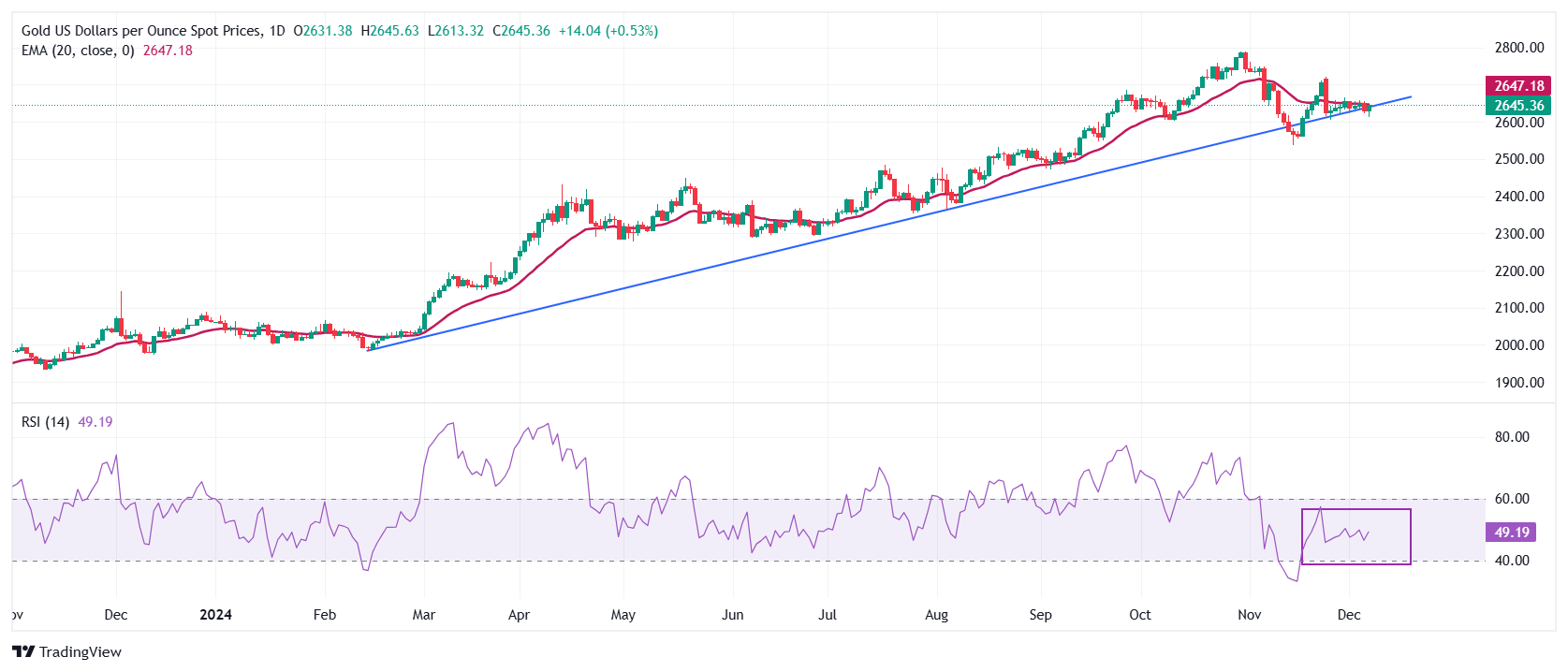- Gold price bounces back and moves higher ahead of the US NFP data for November, which will influence market expectations for the Fed’s interest-rate path.
- Traders lean toward the Fed reducing interest rates by 25 basis points on December 18.
- The violation of truce terms between Israel and Hezbollah has reignited tensions in the Middle East, providing further support to Gold.
Gold price (XAU/USD) recovers intraday losses and edges higher to around$2,640 in European trading hours on Friday ahead of the United States (US) Nonfarm Payrolls (NFP) data for November, a key release to get more cues about which direction US interest rates could be heading to.
The impact of the US labor market data on the Federal Reserve’s (Fed) likely interest rate action in the policy meeting on December 18 will be significant as officials became more focused on preserving labor demand when the central bank started reducing its key borrowing rates in September. The data will be released at 13:30 GMT.
According to the CME FedWatch tool, there is a 72% chance that the Fed will reduce interest rates by 25 basis points (bps) to 4.25%-4.50% this month, while the rest supports leaving interest rates unchanged.
Lower interest rates are positive for Gold because they reduce the opportunity cost of holding the non-interest-paying asset.
Economists expect the US economy to have added 200K fresh workers, significantly higher than 12K in October. The prior month’s NFP report stated that payroll employment estimates in some industries were affected by the hurricanes. The Unemployment Rate is estimated to have increased to 4.2% from 4.1%.
Investors will also pay close attention to the US Average Hourly Earnings data to get cues about the current status of wage growth. The measure is estimated to have increased by 3.9%, slower than 4% in October, on a year-on-year basis.
Ahead of the US NFP data, the US Dollar Index (DXY) – which tracks the Greenback’s value against six major currencies – holds the key support of 105.70. Meanwhile, 10-year US Treasury yields rise to nearly 4.19%.
Renewed tensions in Middle East keep the Gold prce well-supported
- Gold price is expected to face increased volatility as traders brace for the US official labor market data. However, heightened geopolitical tensions would continue to support the Gold price downside.
- The ceasefire agreement in the Middle East region between Israel and Hezbollah appears to be shaking as tensions have reignited, with each party blaming the other for violating the truce terms. The Israeli army carried out an array of airstrikes late Monday on Hezbollah in retaliation to their attack by two projectiles on the Israeli military post near Lebanon.
- Meanwhile, the war between Russia and Ukraine also keeps the broader risk appetite on its toes. Russian foreign minister Sergey Lavrov warned that Russia is ready to use any means to prevent the West from achieving its goal of inflicting a “strategic defeat” on the country, in an interview with US journalist Tucker Carlson, ThePrint reported.
- Heightened geopolitical tensions and global uncertainty improve the appeal of safe-haven assets such as Gold.
Technical Analysis: Gold price wobbles near 20-day EMA
Gold price trades back and forth near the upward-sloping trendline around $2,650, which is plotted from the February low of $1,984.00 on the daily time frame. The precious metal wobbles near the 20-day Exponential Moving Average (EMA), which also trades around $2,650.
The 14-day Relative Strength Index (RSI) oscillates in the 40.00-60.00 range, very close to the neutral level of 50, suggesting a sideways trend.
Looking down, the November low of around $2,537 will be the key support for Gold price bulls. On the upside, the October and all-time high of $2,790 will act as key resistance.
Economic Indicator
Nonfarm Payrolls
The Nonfarm Payrolls release presents the number of new jobs created in the US during the previous month in all non-agricultural businesses; it is released by the US Bureau of Labor Statistics (BLS). The monthly changes in payrolls can be extremely volatile. The number is also subject to strong reviews, which can also trigger volatility in the Forex board. Generally speaking, a high reading is seen as bullish for the US Dollar (USD), while a low reading is seen as bearish, although previous months’ reviews and the Unemployment Rate are as relevant as the headline figure. The market’s reaction, therefore, depends on how the market assesses all the data contained in the BLS report as a whole.

